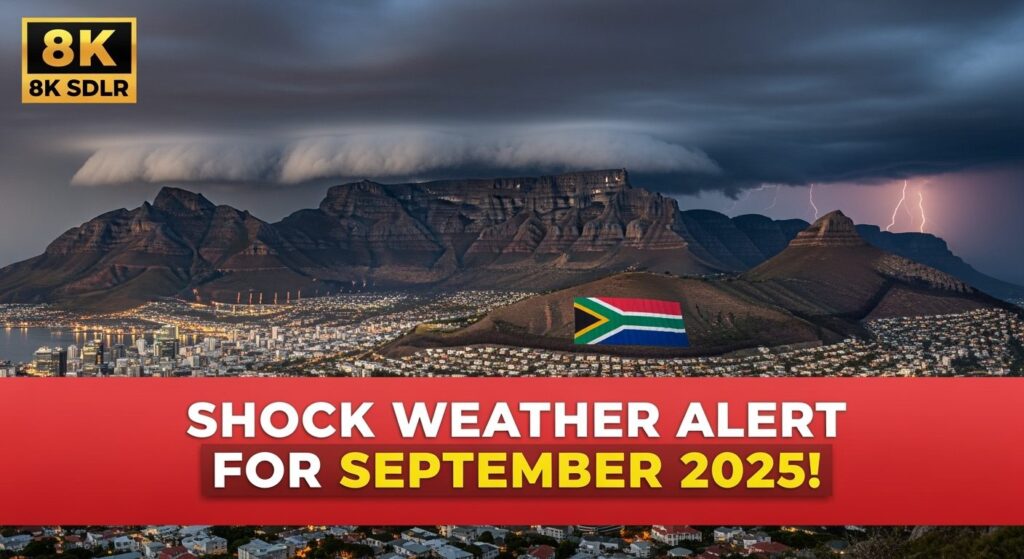Storm warnings across South Africa: As we move deeper into September 2025, I’ve been closely monitoring the concerning weather patterns developing across South Africa. The meteorological department has issued multiple storm warnings affecting several provinces, with particular emphasis on coastal regions and central highlands. Have you prepared your home for the potential impact of these weather systems? The unusual intensity of these September storms has meteorologists comparing them to historical weather events from previous decades, suggesting we might be witnessing climate pattern shifts that deserve our immediate attention.

What Are The Current Storm Warnings?
The September 2025 weather update indicates severe storm warnings across South Africa, particularly targeting the Eastern Cape, KwaZulu-Natal, and Western Cape provinces. These systems are characterized by wind speeds exceeding 100 km/h in coastal areas, with rainfall predictions of 150-200mm in a 24-hour period for some regions. The South African Weather Service has issued red alerts for flash flooding in low-lying areas and potential landslides in mountainous regions. I’m particularly concerned about urban drainage systems that may not handle this volume of precipitation, especially in townships and informal settlements where infrastructure is already strained.
Why Are These Storms Unusually Severe?
Meteorologists attribute the intensity of these storm warnings across South Africa to several converging climate factors. The primary driver appears to be abnormally warm Indian Ocean temperatures, approximately 2°C above historical September averages. This excess heat energy fuels stronger storm systems as they develop offshore. Additionally, shifting jet stream patterns have created atmospheric conditions conducive to storm intensification over the subcontinent. Climate scientists I’ve consulted suggest these patterns align with climate change models that predict more extreme weather events. The timing is particularly problematic as many agricultural regions are in critical growing phases, potentially threatening food security if widespread crop damage occurs.
How To Prepare For The Incoming Storms
With these storm warnings across South Africa, preparation is essential. I recommend securing loose objects around your property that could become projectiles in high winds. Ensure your gutters and drainage systems are clear of debris to prevent water backup and potential structural damage. Prepare an emergency kit containing essential medications, non-perishable food, water, flashlights, and battery-powered radios. Charge all communication devices while power is stable, as outages are likely in affected areas. If you live in flood-prone areas, consider temporary relocation to higher ground or designated emergency shelters. The government has established emergency response centers in major cities, with contact information available through the national disaster management app.
| Emergency Item | Recommended Quantity |
|---|---|
| Drinking Water | 5 liters per person per day |
| Non-perishable Food | 3-day supply minimum |
| Flashlights | 1 per family member |
| First Aid Kit | 1 comprehensive kit |
When Will The Storm Systems Pass?
According to the September 2025 weather update, these storm systems are expected to affect South Africa for approximately 7-10 days. The first wave will likely impact the Western Cape by September 15th, moving eastward across the country over the following 48-72 hours. Secondary systems are developing offshore and may make landfall around September 20-22, potentially extending the severe weather period. Meteorological models suggest conditions should begin stabilizing by month-end, though isolated thunderstorms may persist in northeastern regions. I’ll be monitoring these predictions closely, as weather patterns have shown increased unpredictability in recent years. Remember that even after the main systems pass, waterlogged ground can continue to pose risks.
Cape Town’s Preparation Measures
Cape Town officials have implemented extensive preparation measures ahead of the forecasted storms. The city has deployed additional drainage teams to clear critical waterways and storm drains in flood-prone areas like Khayelitsha and Masiphumelele. Emergency services have been placed on high alert with additional staff and equipment positioned strategically throughout the metropolitan area. The city’s disaster management center has established temporary shelters in community halls and schools, with capacity for approximately 5,000 displaced residents. These proactive measures reflect lessons learned from the devastating 2023 flash floods that caught many communities unprepared.
As we navigate through these storm warnings across South Africa, I urge you to stay informed through official channels and prioritize safety above all else. Has your community established neighborhood support networks for vulnerable residents during extreme weather? These collective efforts often make the critical difference in disaster resilience. I’ll continue providing updates as the situation develops throughout September 2025.





